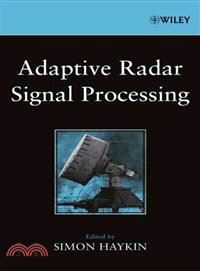Adaptive Radar Signal Processing
商品資訊
ISBN13:9780471735823
出版社:John Wiley & Sons Inc
作者:Haykin
出版日:2006/10/27
裝訂/頁數:精裝/248頁
定價
:NT$ 5774 元優惠價
:90 折 5197 元
若需訂購本書,請電洽客服 02-25006600[分機130、131]。
商品簡介
作者簡介
目次
相關商品
商品簡介
This collaborative work presents the results of over twenty years of pioneering research by Professor Simon Haykin and his colleagues, dealing with the use of adaptive radar signal processing to account for the nonstationary nature of the environment. These results have profound implications for defense-related signal processing and remote sensing. References are provided in each chapter guiding the reader to the original research on which this book is based.
作者簡介
SIMON HAYKIN, PhD, is Distinguished University Professor in the Department of Electrical and Computer Engineering at McMaster University. He has pioneered signal-processing techniques and systems for radar and communication applications, and authored several acclaimed textbooks. Dr. Haykin has received numerous awards for his research including Honorary Doctor of Technical Sciences from ETH Zurich, Switzerland, and the first International Union of Radio Science Henry Booker Gold Medal.
目次
Preface.
Contributors List.
1. Introduction (Simon Haykin).
Experimental Radar Facilities.
Organization of the Book.
Part I Radar Spectral Analysis.
2. Angle-of-Arrival Estimation in the Presence of Multipath (Anastasios Drosopoulos and Simon Haykin).
2.1 Introduction.
2.2 The Low-Angle Tracking Radar Problem.
2.3 Spectrum Estimation Background.
2.3.1 The Fundamental Equation of Spectrum Estimation.
2.4 Thomson’s Multi-Taper Method.
2.4.1 Prolate Spheroidal Wavefunctions and Sequences.
2.5 Test Dataset and a Comparison of Some Popular Spectrum Estimation Procedures.
2.5.1 Classical Spectrum Estimation.
2.5.2 MUSIC and MFBLP.
2.6 Multi-taper Spectrum Estimation.
2.6.1 The Adaptive Spectrum.
2.6.2 The Composite Spectrum.
2.6.3 Computing the Crude, Adaptive, and Composite Spectra.
2.7 F-Test for the Line Components.
2.7.1 Brief Outline of the F-Test.
2.7.2 The Point Regression Single-Line F-Test.
2.7.3 The Integral Regression Single-Line F-Test.
2.7.4 The Point Regression Double-Line F-Test .
2.7.5 The Integral Regression Double-Line F-Test.
2.7.6 Line Component Extraction.
2.7.7 Prewhitening.
2.7.8 Multiple Snapshots.
2.7.9 Multiple Snapshot, Single-Line, Point-Regression F-Tests.
2.7.10 Multiple-Snapshot, Double-Line Point-Regression F-Tests.
2.8 Experimental Data Description for a Low-Angle Tracking Radar Study.
2.9 Angle-of-Arrival (AOA) Estimation.
2.10 Diffuse Multipath Spectrum Estimation.
2.11 Discussion.
References.
3. Time–Frequency Analysis of Sea Clutter (David J. Thomson and Simon Haykin).
3.1 Introduction.
3.2 An Overview of Nonstationary Behavior and Time–Frequency Analysis.
3.3 Theoretical Background on Nonstationarity.
3.3.1 Multi-taper Estimates.
3.3.2 Spectrum Estimation as an Inverse Problem.
3.4 High-Resolution Multi-taper Spectrograms.
3.4.1 Nonstationary Quadratic-Inverse Theory.
3.4.2 Multi-taper Estimates of the Loève Spectrum.
3.5 Spectrum Analysis of Radar Signals.
3.6 Discussion.
3.6.1 Target Detection Rooted in Learning.
References.
Part II Dynamic Models.
4. Dynamics of Sea Clutter (Simon Haykin, Rembrandt Bakker, and Brian Currie).
4.1 Introduction.
4.2 Statistical Nature of Sea Clutter: Classical Approach.
4.2.1 Background.
4.2.2 Current Models.
4.3 Is There a Radar Clutter Attractor?
4.3.1 Nonlinear Dynamics.
4.3.2 Chaotic Invariants.
4.3.3 Inconclusive Experimental Results on the Chaotic Invariants of Sea Clutter.
4.3.4 Dynamic Reconstruction.
4.3.5 Chaos, a Self-Fulfi lling Prophecy?
4.4 Hybrid AM/FM Model of Sea Clutter.
4.4.1 Radar Return Plots.
4.4.2 Rayleigh Fading.
4.4.3 Time-Doppler Spectra.
4.4.4 Evidence for Amplitude Modulation, Frequency Modulation, and More.
4.4.5 Modeling Sea Clutter as a Nonstationary Complex Autoregressive Process.
4.5 Discussion.
4.5.1 Nonlinear Dynamics of Sea Clutter.
4.5.2 Autoregressive Modeling of Sea Clutter.
4.5.3 State-Space Theory.
4.5.4 Nonlinear Dynamical Approach Versus Classical Statistical Approach.
4.5.5 Stochastic Chaos.
References.
Appendix A Specifi cations of the Three Sea-Clutter Sets Used in This Chapter.
5. Sea-Clutter Nonstationarity: The Infl uence of Long Waves (Maria Greco and Fulvio Gini).
5.1 Introduction.
5.2 Radar and Data Description.
5.3 Statistical Data Analyses.
5.4 Modulation of Long Waves: Hybrid AM/FM Model.
5.5 Nonstationary AR Model.
5.6 Parametric Analysis of Texture Process.
5.7 Discussion.
5.7.1 Autoregressive Modeling of Sea Clutter.
5.7.2 Cyclostationarity of Sea Clutter.
References.
6. Two New Strategies for Target Detection in Sea Clutter (Rembrandt Bakker, Brian Currie, and Simon Haykin).
6.1 Introduction.
6.2 Bayesian Direct Filtering Procedure.
6.2.1 Single-Target Scenario.
6.2.2 Conditioning on Past and Future Measurements.
6.3 Operational Details.
6.3.1 Experimental Data.
6.3.2 Statistics of Sea Clutter.
6.3.3 Statistics of Target Returns.
6.3.4 Motion Model of the Target.
6.4 Experimental Results on the Bayesian Direct Filter.
6.5 Additional Notes on the Bayesian Direct Filter.
6.6 Correlation Anomally Detection Strategy.
6.7 Experimental Comparison of the Bayesian Direct Filter and Correlation Anomaly Receiver.
6.7.1 Target-to-Interference Ratio.
6.7.2 Receiver Comparison.
6.8 Discussion.
6.8.1 Further Research.
References.
Index.
Contributors List.
1. Introduction (Simon Haykin).
Experimental Radar Facilities.
Organization of the Book.
Part I Radar Spectral Analysis.
2. Angle-of-Arrival Estimation in the Presence of Multipath (Anastasios Drosopoulos and Simon Haykin).
2.1 Introduction.
2.2 The Low-Angle Tracking Radar Problem.
2.3 Spectrum Estimation Background.
2.3.1 The Fundamental Equation of Spectrum Estimation.
2.4 Thomson’s Multi-Taper Method.
2.4.1 Prolate Spheroidal Wavefunctions and Sequences.
2.5 Test Dataset and a Comparison of Some Popular Spectrum Estimation Procedures.
2.5.1 Classical Spectrum Estimation.
2.5.2 MUSIC and MFBLP.
2.6 Multi-taper Spectrum Estimation.
2.6.1 The Adaptive Spectrum.
2.6.2 The Composite Spectrum.
2.6.3 Computing the Crude, Adaptive, and Composite Spectra.
2.7 F-Test for the Line Components.
2.7.1 Brief Outline of the F-Test.
2.7.2 The Point Regression Single-Line F-Test.
2.7.3 The Integral Regression Single-Line F-Test.
2.7.4 The Point Regression Double-Line F-Test .
2.7.5 The Integral Regression Double-Line F-Test.
2.7.6 Line Component Extraction.
2.7.7 Prewhitening.
2.7.8 Multiple Snapshots.
2.7.9 Multiple Snapshot, Single-Line, Point-Regression F-Tests.
2.7.10 Multiple-Snapshot, Double-Line Point-Regression F-Tests.
2.8 Experimental Data Description for a Low-Angle Tracking Radar Study.
2.9 Angle-of-Arrival (AOA) Estimation.
2.10 Diffuse Multipath Spectrum Estimation.
2.11 Discussion.
References.
3. Time–Frequency Analysis of Sea Clutter (David J. Thomson and Simon Haykin).
3.1 Introduction.
3.2 An Overview of Nonstationary Behavior and Time–Frequency Analysis.
3.3 Theoretical Background on Nonstationarity.
3.3.1 Multi-taper Estimates.
3.3.2 Spectrum Estimation as an Inverse Problem.
3.4 High-Resolution Multi-taper Spectrograms.
3.4.1 Nonstationary Quadratic-Inverse Theory.
3.4.2 Multi-taper Estimates of the Loève Spectrum.
3.5 Spectrum Analysis of Radar Signals.
3.6 Discussion.
3.6.1 Target Detection Rooted in Learning.
References.
Part II Dynamic Models.
4. Dynamics of Sea Clutter (Simon Haykin, Rembrandt Bakker, and Brian Currie).
4.1 Introduction.
4.2 Statistical Nature of Sea Clutter: Classical Approach.
4.2.1 Background.
4.2.2 Current Models.
4.3 Is There a Radar Clutter Attractor?
4.3.1 Nonlinear Dynamics.
4.3.2 Chaotic Invariants.
4.3.3 Inconclusive Experimental Results on the Chaotic Invariants of Sea Clutter.
4.3.4 Dynamic Reconstruction.
4.3.5 Chaos, a Self-Fulfi lling Prophecy?
4.4 Hybrid AM/FM Model of Sea Clutter.
4.4.1 Radar Return Plots.
4.4.2 Rayleigh Fading.
4.4.3 Time-Doppler Spectra.
4.4.4 Evidence for Amplitude Modulation, Frequency Modulation, and More.
4.4.5 Modeling Sea Clutter as a Nonstationary Complex Autoregressive Process.
4.5 Discussion.
4.5.1 Nonlinear Dynamics of Sea Clutter.
4.5.2 Autoregressive Modeling of Sea Clutter.
4.5.3 State-Space Theory.
4.5.4 Nonlinear Dynamical Approach Versus Classical Statistical Approach.
4.5.5 Stochastic Chaos.
References.
Appendix A Specifi cations of the Three Sea-Clutter Sets Used in This Chapter.
5. Sea-Clutter Nonstationarity: The Infl uence of Long Waves (Maria Greco and Fulvio Gini).
5.1 Introduction.
5.2 Radar and Data Description.
5.3 Statistical Data Analyses.
5.4 Modulation of Long Waves: Hybrid AM/FM Model.
5.5 Nonstationary AR Model.
5.6 Parametric Analysis of Texture Process.
5.7 Discussion.
5.7.1 Autoregressive Modeling of Sea Clutter.
5.7.2 Cyclostationarity of Sea Clutter.
References.
6. Two New Strategies for Target Detection in Sea Clutter (Rembrandt Bakker, Brian Currie, and Simon Haykin).
6.1 Introduction.
6.2 Bayesian Direct Filtering Procedure.
6.2.1 Single-Target Scenario.
6.2.2 Conditioning on Past and Future Measurements.
6.3 Operational Details.
6.3.1 Experimental Data.
6.3.2 Statistics of Sea Clutter.
6.3.3 Statistics of Target Returns.
6.3.4 Motion Model of the Target.
6.4 Experimental Results on the Bayesian Direct Filter.
6.5 Additional Notes on the Bayesian Direct Filter.
6.6 Correlation Anomally Detection Strategy.
6.7 Experimental Comparison of the Bayesian Direct Filter and Correlation Anomaly Receiver.
6.7.1 Target-to-Interference Ratio.
6.7.2 Receiver Comparison.
6.8 Discussion.
6.8.1 Further Research.
References.
Index.
主題書展
更多
主題書展
更多書展今日66折
您曾經瀏覽過的商品
購物須知
外文書商品之書封,為出版社提供之樣本。實際出貨商品,以出版社所提供之現有版本為主。部份書籍,因出版社供應狀況特殊,匯率將依實際狀況做調整。
無庫存之商品,在您完成訂單程序之後,將以空運的方式為你下單調貨。為了縮短等待的時間,建議您將外文書與其他商品分開下單,以獲得最快的取貨速度,平均調貨時間為1~2個月。
為了保護您的權益,「三民網路書店」提供會員七日商品鑑賞期(收到商品為起始日)。
若要辦理退貨,請在商品鑑賞期內寄回,且商品必須是全新狀態與完整包裝(商品、附件、發票、隨貨贈品等)否則恕不接受退貨。
























